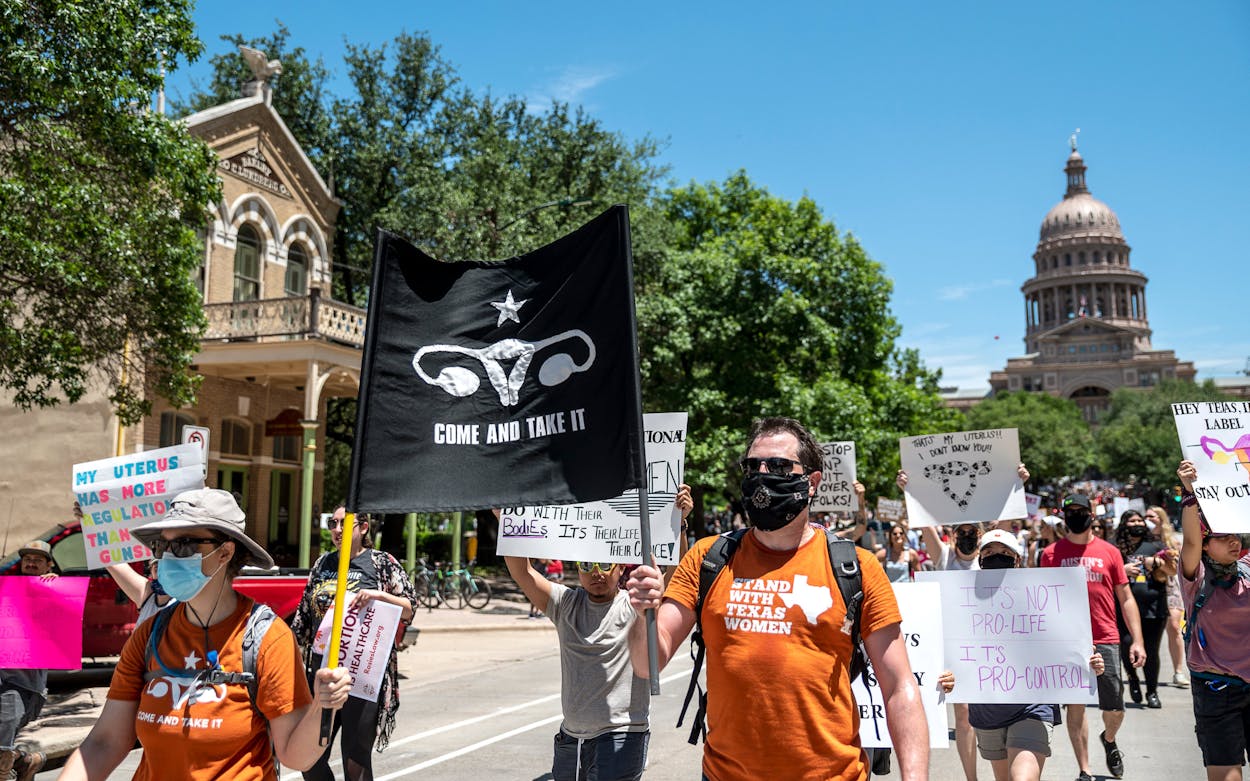I was in my second semester of college in Massachusetts when Roe v. Wade became law in 1973, and what I remember most about it was the pride I felt in Texas women. A Texas woman—“lady lawyer” Sarah Weddington—had won the case with a Texas plaintiff, Norma McCorvey. The case was certainly about the right to safe and legal abortions. It was equally about the rights of women across the country to determine their own fates.
This was a time when classmates were still rubbing my nose in the LBJ years—the Great Society plans were no match for the war in Vietnam—and I took some comfort in what I had seen growing up, with the thankless work of (pre-governor) Ann Richards and likes of Barbara Jordan, Sissy Farenthold, Kaye Northcott, and Molly Ivins. Now, once again, Texas women had figured out a way to get around barriers set up by men, from Texas and beyond, to make better, safer lives for all.
What I also remember are the warnings from women slightly older than I was. Even something as seemingly permanent as a Supreme Court decision could be overturned, they said, and my generation had a responsibility to preserve and protect what our older counterparts had fought so hard for. I was just young enough that stories of women who had to travel to Manhattan for legal abortions and who died from self-induced coat-hanger procedures were just that: stories. They were true stories, I knew, but still stories in which I had a vested interest but no emotional connection.
My psychic investment would change in the coming years, as a great many friends and acquaintances made the hard, often heartbreaking choice to end unplanned and unwanted pregnancies. Some were victims of rape; some simply could not afford, financially and/or emotionally, to care for a child. They got their abortions, and, contrary to an opposing and debunked school of thought, were not permanently scarred. They continued their educations, went back to work, cared for the children they already had. And, of course, no one died in a botched procedure. Maybe for those reasons, not enough of us were watching as another cohort of Texans spurred their increasingly more right-wing legislators to find ever-more-creative ways to get around Roe.
As the timeline below shows, it took fifty years, but they were successful. Those women who tried to hold the line for decades saw it coming: a subtle, then increasingly bold, chipping away of Roe in which each new change in a state law did not look so onerous individually, but in the aggregate left few options for Texas women with unwanted pregnancies. It was all done in the name of “protecting” women who, so it went, were incapable of making their own decisions about their health and that of their families.
Now we have come near full circle, with a draconian new law that essentially bans abortion—so called Senate Bill 8—which was temporarily blocked in federal court on Wednesday, then temporarily reinstated by the Fifth U.S. Circuit Court of Appeals on Friday. What becomes obvious from a cursory history of abortion laws is that Roe has been threatened virtually since its passage by its Texas opponents—and that Texas women who want to preserve their constitutional rights will have to continue to clean up the mess their mostly male lawmakers have made.
1973 Roe v. Wade
U.S. Supreme Court overturns Texas law that banned abortion except “for the purpose of saving the mother’s life.” All women now have access to abortion, and Medicaid can be used to cover the costs (until the Hyde Amendment passes in Congress in 1976.)
1977 Texas Occupations Code §§ 103.001–103.004
Governor Dolph Briscoe (D)
“Religious refusal” law
Physicians and other employees of hospitals or other health-care facilities who object “directly or indirectly” to performing or participating in an abortion may not be required to do so. In addition, facilities may not discriminate against staff or applicants who refuse to “perform or participate” in abortions. Private hospitals and private health-care facilities are not required to perform abortions unless a doctor determines that the mother’s life is immediately endangered.
1985 Texas Health & Safety Code § 245.010(b)
Governor Mark White (D)
Only a physician licensed by the state may provide abortion care, and any physician who performs an abortion at an abortion clinic must file detailed annual reports (later amended to be monthly) on the number of abortions provided. Nurses or physician assistants cannot perform abortions.

1999 Texas Family Code §§ 33.001–33.008
Governor George W. Bush (R)
“Parental notification” law
Unless a judge grants permission, a girl under age eighteen cannot get an abortion until 48 hours after a physician has notified at least one of her parents or guardians either in person, by certified mail, or by phone. Exceptions may apply in the event of a medical emergency.
2003 Texas Health & Safety Code §§ 171
Governor Rick Perry (R)
“Woman’s Right to Know Act”
At least 24 hours before performing an abortion, doctors must give patients government-written materials or a web address containing information about abortion, including realistic photos of what a fetus looks like as it grows over two-week intervals, and must tell their patients about available “medical assistance benefits” for prenatal care and childbirth. The “statistical likelihood of collecting child support,” as compiled by the federal government, must also be provided. Physicians are also required to give patients information that is medically questionable, including the false claim that abortions increase the risk of breast cancer, and provide them with a state-mandated list of counseling organizations that includes adoption agencies. In addition, abortions performed at or after sixteen weeks of pregnancy must be performed in a licensed hospital or ambulatory surgical center rather than at a standard clinic, as previously allowed.
2005 Texas Occupations Code § 164.052 (a)(19)
Governor Rick Perry (R)
Physicians can no longer perform abortions on patients under eighteen without obtaining a court order, or a parent’s or legal guardian’s consent. (In 2006, the state created a consent form that required notarization, imposing a further burden.)
2005 Legislative Budget Board, Conference Committee Report on SB1, S. 79, Regular Session, at 11-109 (2005)
Governor Rick Perry (R)
State funding is provided for crisis pregnancy centers (CPCs)—nonprofit organizations, usually religiously affiliated, that counsel pregnant women against having an abortion. Additionally, funds are appropriated for abstinence sex education.
2011 Texas Government Code §§ 402.036-402.037; Texas Transportation Code § 504.662
Governor Rick Perry (R)
State funding, administered by the attorney general, is provided for a “Choose Life” license-plate program that, for $30 a year, gives money to anti-abortion organizations.
2011 Texas Human Resources Code § 32.024 (c-1)
Governor Rick Perry (R)
Texas health and human services agencies can no longer spend taxpayer money to provide or “promote” abortions. The agencies are also forbidden from contracting with any organizations “affiliated” with facilities that provide abortion care. This includes Planned Parenthood’s women’s health-care services, like mammograms, at clinics that do not provide abortions.
2011 Texas Health & Safety Code § 171.012
Governor Rick Perry (R)
Additions to “Woman’s Right to Know Act”
Except in medical emergencies, a doctor must perform a sonogram on the person seeking an abortion at least 24 hours prior to the procedure. Because the sonogram must occur early in pregnancy, the procedure requires the use of a vaginal probe. The doctor must show the images to the patient, and verbally explain what is shown on the screen, including descriptions of the fetus, its heart activity, and its internal organs, and must provide an opportunity for the patient to hear heart activity. (In the same year, the Texas Observer reported that the state legislature voted to cut Texas’s family-planning program by two-thirds, 146 clinics lost state funds, and more than 60 of those clinics closed.)

2013 Texas Health & Safety Code §§ 171.041–171.048
Governor Rick Perry (R)
The legislature agrees to ban abortion after twenty weeks, unless the patient’s life or health is at risk or there is a severe fetal abnormality, meaning it is “incompatible with life outside the womb.”
2013 Texas Health & Safety Code §§ 171.061–171.064
Governor Rick Perry (R)
Abortion-inducing medication can only be dispensed by a physician; nurses and pharmacists are prohibited from doing so. The doctor must schedule a follow-up visit—telemedicine is not allowed—no more than fourteen days after the abortion-inducing medication is taken.
2015 Texas Family Code § 33.002–33.003
Governor Greg Abbott (R)
Additions to “parental consent” law
More requirements are added for girls under the age of eighteen to obtain abortions without parental consent, increasing their burden of proof. A girl must appear in person before the court, where a judge will consider various factors, including her age, “life experiences,” “steps taken by the minor to explore her options and the consequences of those options,” whether she has investigated state-published material on adoption, and whether she should be evaluated by a licensed mental-health counselor, who then has three business days to submit an evaluation to the court for review.
2017 Texas Health & Safety Code § 697.001–697.009
Governor Greg Abbott (R)
“Fetal burial” law
Clinics must bury or cremate the tissue resulting from an abortion or miscarriage. Clinics that do not do so risk losing their license.
2017 Texas Health & Safety Code §§ 171.151–171.154
Governor Greg Abbott (R)
Dilation and evacuation, the most common procedure for second-trimester abortions, is renamed a “dismemberment abortion,” and is banned and classified as a “state jail felony.”
2017 Texas Insurance Code § 1218
Governor Greg Abbott
Abortion is no longer covered in comprehensive insurance plans, meaning that women must buy a separate policy for unplanned pregnancies.
2019 Texas Health & Safety Code §§ 171.011–171.016
Governor Greg Abbott (R)
Updates “Woman’s Right to Know” law
Women who live within a hundred miles of an abortion clinic must receive in-person consultations regarding the state-mandated information (see above) 24 hours before their procedure. Women who live more than a hundred miles from an abortion clinic must speak to an individual counselor by phone or in person. Audio or video recordings, or conference calls, are no longer permitted.
2019 Texas Family Code § 151.002
Governor Greg Abbott (R)
Establishes the “rights of a living child after an abortion or premature birth,” as well as a “physician-patient relationship” between “a child born alive after an abortion and the physician who performed or attempted to perform the abortion.” Doctors must try to transfer any fetus “born alive” after an abortion to a hospital and attempt to save its life. Doctors can be fined $100,000 for violations. A hotline is established in the attorney general’s office, which people can call to report a doctor for alleged violations. (Note: because Texas does not allow abortions after twenty weeks, no fetus can actually be born alive after an abortion.)
2019 Texas Government Code § 2273
Governor Greg Abbott (R)
Prevents government entities from entering into a “taxpayer resource transaction” with an abortion provider or its affiliates. Effectively ends all governmental support for Planned Parenthood.

2021 Senate Bill 8 87(R)
Governor Greg Abbott (R)
“Texas Heartbeat Act”
Abortions are effectively banned after six weeks of pregnancy. Any citizen from any state can sue anyone who helps a woman get an abortion—including doctors, cab drivers, relatives, and others—and receive a $10,000 reward along with legal expenses for each court victory.
2021 House Bill 1280
Governor Greg Abbott (R)
“Trigger bill”
Abortion will be banned in Texas, with no rape or incest exceptions, within thirty days of the U.S. Supreme Court overturning Roe v. Wade.
2021 Senate Bill 4
Governor Greg Abbott (R)
Abortion-inducing medication, like RU486, cannot be used after 49 days of pregnancy. (This is effectively a ban, as many women do not know they are pregnant within seven weeks.) This law also prevents the mailing of these pills to consumers and adds medically dubious reporting requirements for abortion providers, including that they report on complications that happen during subsequent pregnancies.
Correction: The original version of this article stated that Medicaid funding for abortions ended in Texas in 1989. Medicaid funding was no longer available to pay for abortions after Hyde Amendment, passed by the U.S. Congress in 1976, went into effect. The article has been updated.
- More About:
- Politics & Policy
- Abortion








